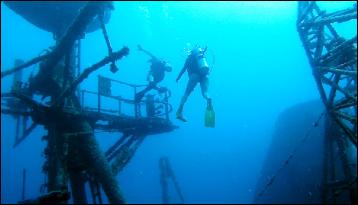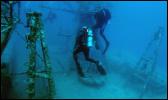 |
||||||
 |
||||||
SAGINAW UNDERWATER EXPLORERS |
||||||
 |
||||||||||||||||||||
 |
 |
|||||||||||||||||||
Design Copyright 2008 by Photo Technician Inc. | Webmaster |
||
Today is:
By Dave Sommers
The sky was a brilliant blue with the water a few shades darker as we departed Key West, headed south. A light breeze stirred the ocean swells.
We were headed for the General Hoyt S. Vandenberg, a old ship that was 520 feet long with a 71.5 ft beam. It was sunk May 27 2009 as an artificial reef in about 150' about 6 miles south of Key West in the Florida Keys National Marine Sanctuary.
There were about 15 of us onboard. This was my second trip to the wreck in three days. It was an interesting mix of divers and experiences, almost like the Gilligan’s Island group.
There was the South African that lived in England and did most of his diving around Scotland, a writer for Consumer Reports from New York, a contractor and his wife from Pittsburgh and an Air Force C5 flight engineer who had been in Afghanistan less than two weeks ago.
There was a crew of three. One dive master said he had moved from "Jersey" a year ago for a change.
I chartered through Captains Corner at the recommendation of club member Bill Giorgis. They have a shop but book their charters from a little Tiki kiosk at the dock. It was not a place I would have chosen without Bills suggestion. New member Manny Trevino dove with them a few weks prior to my trip and gave them high marks. Since I had flown to Key West I needed to rent almost everything, other than my shorty wetsuit. Everything from the check in through the entire dive was handled professionally and the gear was kept on the boat, which would have been helpful if anyone had an equipment malfunction.
I stopped by the kiosk a few days earlier to check it out. Leslie and the staff made check in easy, with a short discussion about diving and skill level. Of course Bill and Manny Trevino had warned them I would be stopping by. A look at my C card (and credit card) and I boarded the Sea Eagle. It is a 60-foot, 37-ton, all aluminum dive vessel. It has giant stride entries and two ladders for ease in getting back into the boat. The craft was in the 1989 James Bond film, "License to Kill." It was a clean and well kept boat, unlike a couple of others I saw along the docks.
I was quick to point out I was not an experienced charter or saltwater diver, with the vast majority of my diving done in the Great Lakes.
The crew was very accommodating in fitting me into gear and assisting in helping switch out their regulator to my full face mask.
The first trip to the wreck was on Tuesday. Since I was diving solo I was pared with another diver. This was the C5 engineer. Being former Air Force, we hit it off good. He has been diving all over the world, except the Great Lakes and has over a dozen dives on the Vandenberg. He made a great guide.
Gear was donned as we pulled up to the buoyed wreck. We were tied of to the 3rd of 5 buoys which put us amidship. After a safety briefing entry was a giant stride of about 6' and a quick swim to a tag line. Then down the line. Visibility was 60' or so and the ship appeared as I hit 20’. We were tied off to a high point on the wreck, at about 50’.
The deck was at about 100' so it made a good reference level. There was no sense in going over the side to touch the bottom, though you could see it, and burn all of our bottom time.
We swam along the port side to the stern then back up the starboard side. It did remind me of some of the steel wrecks in the Great Lakes. There were obviously many more fish, (grouper, barracuda, angles, and others) and marine growth was starting to take hold, and the water clarity was wonderful, even though some of the veterans later complained about it.
We did make a pass through some of the hatches, though you wouldn't consider it a penetration dive. You could clearly see blue water on the other side.
A couple of the signature items are the larger radar dishes on the ship. They were huge and fun to swim around and through.
As time came to an end we stopped at 45' for a few minutes of off gassing then up to 20' where a safety tank had been hung, for more off gassing.
I pulled myself back along the safety line to the boat.
Gear was removed and fresh tanks were added. After about an hour of telling stories and a short boat ride we were over the Cayman Salvor. This steel hulled vessel was built in 1936 and measures 186 feet in length, with a 37 foot beam. Her most distinctive feature is the cable pulley built into her bow. In 1985 her superstructure was removed in preparation for sinking as an artificial reef. While she was being towed to sea, the cable snapped and the ship sank. She sits almost upright on a sand bottom, with the stern in 92 feet of water. Her decks are at 70 feet and most of the vessel's interior compartments and engine room are at 80 feet.
The dive was fairly basic. There was no superstructure. It was fairly open with marine growth. There was an abundance of fish, as usual, with the addition of a large green Moray Eel.
Because of the previous dive, we had limited dive time but still got in 24 minutes.
It was about 35 minutes back to the dock. We did two dives and the boat trip in just over 3 hours.
I was undecided about making a second trip, but my wife and daughters talked me into it. I am glad I went. The second trip was on Thursday and the weather was once again beautiful with light winds. I am not a big fan of big waves and seasickness. This trip was much more comfortable, as I was familiar with the routine, saw a few friendly faces, including my dive buddy, and I had been on the wreck before.
The group wanted to do two dives on the Vandenberg this trip. On our first dive we headed to the bow and watched some fish. The current was a little stronger as there was an incoming tide. It wasn’t bad to swim against, but if you stopped swimming you definitely could feel it push you. It was actually kind of fun to let the current push you along. It was nice to have a down line to hang onto as the current pushed you about. Both dives on the second day were great, though we did have to limit some of our time on the second dive, even though we spent an hour on the surface off gassing.
One thing I had never seen was what someone referred to as a knotted “chicken line”. When we entered the water there was a trailing tag line off the boat. Because of the current it was a good line to grab onto. From a floating buoy at the end of the tag line there was a underwater line that lead to the anchor/down line. It was at about 20'. I have often used a trailing line that leads to my anchor line. Just never had seen one at 20’. This made it easy to descend at the tag line, pull yourself along underwater, saving air and exertion, to the down line, where the safety bottle was, then pull yourself down the anchor line to the wreck. On the return, you followed it in reverse, and came back to you boat. A couple of our group came up the wrong line and had to be retrieved from a competitors dive boat.
I got in a total of four dives and had a great experience. It was fun to dive with visibility and out of my dry suit, though I do like the fresh water of the Great Lakes. I hope to get back again.